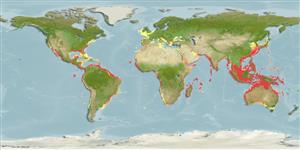Common names from other countries
Classification / Names / Names
俗名 | 同种异名 | Catalog of Fishes (gen., sp.) | ITIS | CoL | WoRMS
Environment: milieu / climate zone / depth range / distribution range
生态学
底中水层性; 深度上下限 0 - 200 m (Ref. 78527). ; 61°N - 40°S, 130°W - 160°E (Ref. 1397)
Indo-Pacific and the Atlantic Ocean.
Length at first maturity / 大小 / 重量 / 年龄
Maturity: Lm ?, range 49 - ? cm Max length : 76.0 cm CL 雄鱼/尚未辨别雌雄; (Ref. 418); common length : 75.0 cm CL 雄鱼/尚未辨别雌雄; (Ref. 1397); 最大体重: 43.4 kg (Ref. 1397)
The olive ridley turtle has a slightly deeper body than the Kemp’s ridley. In adults; carapace nearly round; upturned on the lateral margins; flat on top; its width 90 percent of its length (Straight Curved Length (SCL)). Head: subtriangular; moderate-sized; averaging 22.4 percent of straight carapace length (SCL). Hatchlings: relatively bigger heads (39 percent SCL); longer carapaces (width 78 percent SCL); flippers comparatively bigger than in adults. In 3-year old juveniles: the carapace width, 93 percent of SCL; head length, 26 percent of SCL. Scales and scutes: same configuration as in the Kemp’s ridley; but the lateral scutes are often more than five pairs; the first pair is always in touch with the precentral scute. Also has openings of the Rathke’s glands on the plastral bridges; through a pore on the rear part of each inframarginal scute Fore flippers with 1 or 2 visible claws on the anterior border; sometimes another small claw in the distal part; rear flippers also with 2 claws. Males: larger more strongly curved claws; as well as a longer tail. Color: adults, plain olive-grey above; creamy or whitish; with pale grey margins underneath. Newborn hatchlings: when wet; almost completely black; sometimes with greenish sides; in general, become dark grey after drying. With growth; they change to grey dorsally and white underneath.
This species is the most abundant sea turtle in the world. Frequently neritic, usually migrates along the continental shelves and feeds in shallow waters (Ref. 1397) but also dives deeper than 150 m (Ref. 78527). Shallow coastal waters; open sea forming schools (Ref. 417). Habitat is a warm vertically stratified water with deep thermocline (Ref. 78527). Observed to be basking on sand beaches (Ref. 1397). Nesting patterns range from solitary to small groups to arribadas (Ref. 97534). Little information exists on the feeding behavior of post-hatchlings and juveniles in pelagic waters, but they are most likely exclusively carnivorous, consuming, for instance, invertebrates and fish eggs. Older juveniles and adults feed on a wide variety of benthic organisms (Ref. 122680).
Life cycle and mating behavior
成熟度 | 繁殖 | 产卵场 | 卵 | 孕卵数 | 仔鱼
Mating occurs before and during nesting season near nesting beaches, along migratory routes or at the sea surface. When disturbed, they dive. It is assumed that promiscuity may occur but was not yet reported. Nesting season occurs in summer and autumn but varies from place to place. The reproductive cycle is almost annual which occurs every 14 or 28 days and repeats two to eight times per season. The mean number of eggs per clutch is around 109 eggs which usually ranges from a couple of dozen to more than 155 eggs. Incubation period extends from 45 to 65 days. Egg mean diameter ranges from 3.21 to 4.47 cm and 30 to 38 g in weight. Hatchlings ranges between 3.47 and 4.46 cm straight carapace length and from 12 to 22.3 g in body weight. Sizes and weight varies in different populations and localities (Ref. 1397). Temperature-dependent Sex Determination (TSD) is demonstrated in this species (Refs. 83974, 83976).
主要参考文献
参考文献 | 合作者 | 合作者
Hirth, H.F. 1993. (Ref. 97534)
世界自然保护联盟红皮书 (Ref. 130435)
人类利用
渔业: 商业性
| FishSource | 周边海洋
工具
网络资源
Estimates based on models
Preferred temperature
(Ref.
115969): 22.1 - 29, mean 27.5 (based on 3066 cells).
回复力
中等的, 族群倍增时间最少 1.4 - 4.4年 (K=0.14-0.18; tm=8).
脆弱性
Moderate to high vulnerability (50 of 100).
价格分类
Unknown.
